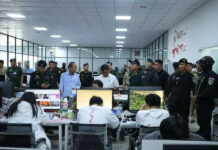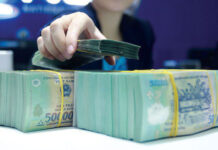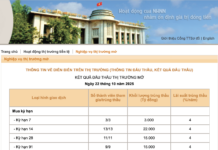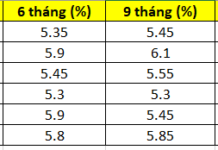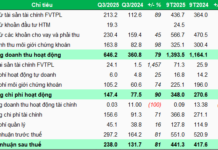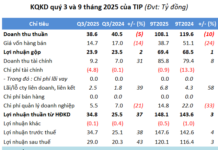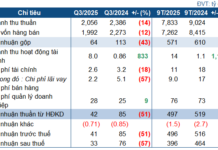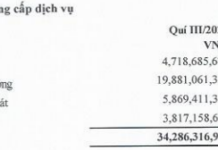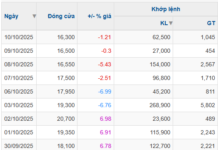Information on the progress of the project to prepare the Ho Chi Minh City Ring Road 4 (Ring Road 4), on February 23, Mr. Tran Quang Lam – Director of the Department of Transport (DOT) of Ho Chi Minh City – said that Ring Road 4 is 206.8 km long and passes through 5 provinces and cities. In which, the section belonging to Ba Ria – Vung Tau province is 18.7 km long; Dong Nai: 45.6 km; Binh Duong: 47.45 km; Ho Chi Minh City: 17.3 km; Long An: 78.3 km.
Responsibility and unity
According to Mr. Tran Quang Lam, the section of Ring Road 4 across the Sai Gon River – Thay Cai Canal, 17.3 km long, will be managed by Ho Chi Minh City – the competent authority, with a total investment of 14,500 billion VND.
Currently, the DOT of Ho Chi Minh City has completed the feasibility study report of the project and is coordinating with the Consulting Consortium to review the opinions of the departments, units as well as adjusting the detailed planning to reduce the compensation for clearance of existing residential areas. It is expected that in the second and third quarters of 2024, the investment policy will be submitted. Construction is expected to start in the third quarter of 2024.
According to Mr. Lam, recently the localities have cooperated responsibly and united in implementing the Ring Road 4 project. The DOT of Ho Chi Minh City proposed to the Ministry of Transport to assign the General Company of Transport Design Consultation to study, review, and prepare an overall evaluation report for the entire route. The Ministry of Transport will preside over and guide the localities to report, advise the Prime Minister on the scale, general technical standards, phased investment of the project, as a basis for implementation and completion of the feasibility study report.
Regarding the investment plan, Mr. Lam said that the localities support option 1 – the localities will be the competent agencies to implement the project. In particular, the section passing through Nha Be district (Ho Chi Minh City), 3.8 km long, will be entrusted to Long An province as the competent agency and assigned to Ho Chi Minh City to carry out using the city’s budget.
“The current obstacle is the phased investment scale between the projects have not agreed on the width of the cross-section; there is no mechanism for localities to use the budget to implement the project as well as to allow the use of the local budget to support other localities in public investment for the project. In addition, the budget of localities is currently scarce. This is a large project that passes through many localities, therefore, it needs special mechanisms and policies like Ring Road 3 to accelerate the progress,” Mr. Lam said.
According to the resolution of the Provincial People’s Council of Binh Duong province, the section of Ring Road 4 passing through Binh Duong province starts from Thu Bien bridge (Bac Tan Uyen district) through VSIP III Industrial Park, intersects with Ho Chi Minh City – Thu Dau Mot – Chon Thanh expressway in Tan Uyen town. Then, it passes through VSIP 2A Industrial Park (Thu Dau Mot city), My Phuoc 3 Industrial Park (Ben Cat town)… and ends in Ben Cat town, crossing the Sai Gon River (Cu Chi district, Ho Chi Minh City).
On November 6, 2023, the People’s Committee of Binh Duong province issued a decision to allocate capital for the project, which is 7,500 billion VND. Currently, the project is carrying out the work of drafting and submitting for appraisal, approval of the pile sinking design documents (boundary design) for drafting, submitting for appraisal, and approval of the feasibility study report.
Binh Duong province plans to approve the component projects in March 2024; clear and hand over a minimum of 50% in the second quarter of 2024, 70% of the land in the third quarter of 2024, and complete the entire land clearance work in 2024.
Mr. Vo Van Minh – Chairman of Binh Duong Provincial People’s Committee – has requested departments, boards, branches, and localities to focus on coordination and implementation of the steps according to the agreed plan and contents, avoiding affecting the overall progress of the project based on compliance with the provisions of the law. For localities with projects passing through, there is a requirement to establish a project steering committee of the locality to coordinate in guiding the implementation of the project.
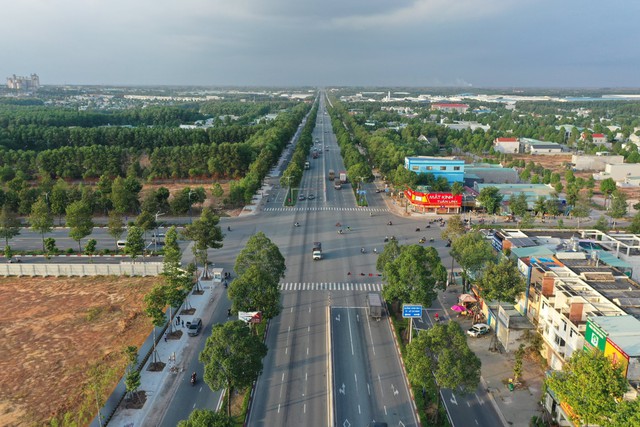
A section of Ho Chi Minh City Ring Road 4 passing through the territory of Ben Cat town has been invested by Binh Duong province. Photo: Thao Nguyen
Implementing urgently
Mr. Vo Van Phi – Deputy Chairman of Dong Nai Provincial People’s Committee – said that the province has also included the Ring Road 4 project in the public investment plan but the implementation process has not been approved yet, due to the large investment budget. If it is agreed to choose a PPP investment option of 50%, Dong Nai will support the width of the cross-section of the line from 25.5-27 meters to ensure aesthetics and safety. Dong Nai proposes to adjust the ratio of budget allocation to 53% instead of the current 50%, continuously for 5 years, to provide Dong Nai with additional resources to complete the set goals and tasks, including Ring Road 4.
The total investment capital for the section of Ring Road 4 passing through Dong Nai is nearly 17,000 billion VND, in which compensation cost for land clearance is over 7,800 billion VND, and the remaining is construction cost.
Regarding the bridge construction connecting Binh Duong and Dong Nai provinces, Dong Nai proposes Binh Duong to undertake. According to the People’s Committee of Dong Nai province, the province has agreed on the cross-section option of Ring Road 4 through Dong Nai province in phase 1 with a width of 22 meters, including 4 express lanes, 2 continuous emergency lanes, medians, and arranged collector roads in residential areas. In terms of progress, Dong Nai has agreed on the completion of the expected feasibility study report in the third quarter of 2024; compensation, support, and resettlement work, and the construction of some auxiliary items are expected to be completed in the second quarter of 2025. The project will be completed and put into operation by the beginning of 2028.
Mr. Nguyen Bon – Deputy Director of the Department of Transport of Dong Nai province, said that the most difficult part is the specific mechanism for landfill materials. Currently, most of the material mines are land owned by people, privately cultivated, and produced, so there is no shortage of materials but there is a shortage due to the mechanism.
The Standing Committee of the Provincial Party Committee of Ba Ria – Vung Tau province has just submitted a report to the Standing Committee of the Provincial Party Committee, the Standing Board of the Provincial Party Committee requesting approval for the investment plan for the Ring Road 4 project section through the province. Accordingly, this section is 18.23 km long, starting at the intersection of Toc Tien – Chau Pha in the area of the intersection with the Bien Hoa – Vung Tau expressway and DT992 road, about 230m from the Bien Hoa – Vung Tau expressway; the endpoint is in Chau Duc district, connecting to Ring Road 4 section through Dong Nai province.
Ba Ria – Vung Tau province said that in the second quarter of 2024, the province will complete the work on the preparation, appraisal, and approval of the feasibility study report; in the fourth quarter of 2024, it will complete the work on the preparation, examination, appraisal, and approval of the feasibility study report. From the second quarter of 2024 to the second quarter of 2025, it will complete the compensation, support, resettlement work, and the construction of some auxiliary items. From the fourth quarter of 2024 to the fourth quarter of 2027, the province will select investors and implement the project.
Mr. Pham Viet Thuan – Director of the Institute of Economic, Natural Resources, and Environment of Ho Chi Minh City – said that this is a key project, which is of great significance for the socio-economic development of the Southeast region and localities. This project is very long, passing through 5 localities, therefore, to ensure consistent, on-schedule implementation, the Central Government needs to have special policies, mechanisms for localities.
Regarding capital, the Central Government should base on the budget situation of localities to provide a reasonable level of support. Dare to delegate autonomy, self-determination to Ho Chi Minh City and provinces to solve issues related to compensation for clearance. In addition, the design work is also entrusted to localities so that it is suitable for topography, terrain as proposed by Ho Chi Minh City, which is to build a high embankment instead of a low lying one to avoid a shortage of building materials and to adapt to climate change.
To expedite the progress, localities should assign EPC bidding package (general contractor contract) to major conglomerates, corporation groups from the design to the construction phase. Having a general contractor who takes primary responsibility, the state management agency will reduce human resources and management costs, have time to focus on researching large-scale projects, with high requirements for techniques and the use of new technologies.
Recommend special mechanisms
To ensure the feasibility and accelerate the implementation progress of the Ring Road 4 project, the representative of the Department of Transport of Ho Chi Minh City proposed the need for special mechanisms, policies specifically applied to the project passed by the National Assembly. Specifically, the provincial People’s Committee acts as the management agency, using the local budget and other legal capital for investment; The local budget should be used to support other localities to implement public investments for the project through two localities.
In addition, the central budget supports 50% of the total budgetary capital for Ho Chi Minh City, Binh Duong, Dong Nai, and Ba Ria – Vung Tau provinces. Long An province supports 70% of the capital source. In terms of the sequence, procedures, authorization, investment decision of component projects are implemented similarly to Group A projects on public investment and have mechanisms for exploiting minerals as normal construction materials…
Boldly delegate autonomy
In assessing this project, Mr. Pham Viet Thuan – Director of the Institute of Economic, Natural Resources, and Environment of Ho Chi Minh City – said that this is a key project, with great significance in the economic and social development of the Southeast region and localities. This project is very long, passing through 5 localities, therefore, to ensure consistent, on-time progress, the Central Government needs to have special policies, mechanisms for localities.
In terms of capital, the Central Government should base on the budget situation of localities to provide a reasonable level of support. Boldly delegate autonomy and decision-making power to Ho Chi Minh City and provinces to settle issues related to compensation for clearance. In addition, the design work should also be entrusted to localities to suit topography, terrain as proposed by Ho Chi Minh City, such as building a high embankment instead of a low lying one to avoid a shortage of construction materials and adapt to climate change.
To expedite the progress, localities should assign the EPC bidding package (general contractor contract) to large corporations, conglomerates to carry out from the design to the construction phase. With a general contractor who takes primary responsibility, the state management agency will reduce human resources and management costs, have time to focus on researching large-scale projects with high requirements for techniques and the use of new technologies.



